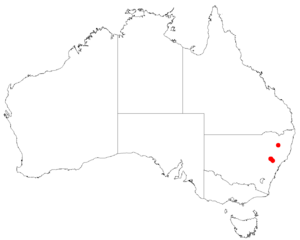Prostanthera discolor facts for kids
Prostanthera discolor is a special kind of flowering plant. It belongs to the Lamiaceae family, which includes mint plants. This plant is found only in a small area of New South Wales, Australia. It's an open, upright shrub that smells very strong. Its flowers are a beautiful deep purple color with darker spots inside.
Quick facts for kids Prostanthera discolor |
|
|---|---|
| Conservation status | |
| Scientific classification | |
| Genus: |
Prostanthera
|
| Species: |
discolor
|
 |
|
| Occurrence data from AVH | |
What Does It Look Like?
Prostanthera discolor is an open, upright shrub. It often grows to be about 0.6 to 3 meters tall. Its branches are hairy and have tiny glands. These glands help give the plant its strong smell.
The leaves are a dull, dark green color. They are lighter on the underside and mostly smooth, without hairs. The leaves are shaped like a spear or are somewhat oblong. They are about 8 to 28 millimeters long and 1 to 5 millimeters wide. Each leaf sits on a small stalk about 1 to 3 millimeters long.
The flowers grow one by one in the upper parts of the plant where the leaves meet the stem. Small leaf-like parts, called bracteoles, are found at the base of the flowers. The green parts that protect the flower bud, called sepals, are about 4 to 5 millimeters long. They form a tube about 2 to 2.5 millimeters wide. The upper part of this tube is about 4 to 5 millimeters long.
The petals of the flower are a deep mauve to purple color. They have darker marks inside the flower tube. The petals are about 7 to 10 millimeters long. This plant usually blooms from September to October.
How It Got Its Name
The plant Prostanthera discolor was first officially described in 1896. This was done by a scientist named Richard Thomas Baker. He wrote about it in a publication called Proceedings of the Linnean Society of New South Wales.
Where It Lives
This special mint bush grows in forests. It is often found in gullies, which are small valleys. It prefers rocky areas. You can find it in the Sandy Hollow and Merriwa areas of New South Wales.
Why It Needs Protection
Prostanthera discolor is considered a "vulnerable" species. This means it is at risk of disappearing. Both the Australian Government and the New South Wales Government protect it under their conservation laws.
In the year 2000, scientists estimated there were only about 110 of these plants left in the wild. The main dangers to this plant include pollution in nearby streams. Also, goats eating the plants is a problem. The fact that there are so few of these plants left also makes them very vulnerable.


